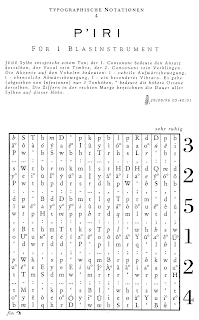... two specimens, one (P'iri) (is) rather demanding and shows the use of typographic notation for qualities of performance normally not notated, while the other (# IV) is quite plain and we used to play it on picnics at the time. It shows the use of letter notation (related to Javanese notation) for pitches or, rather, scale degrees (actually derived from the early Arab theorists who inherited it from the Greek), but using it for variable, indeterminate scales. Use of numerals to indicate duration is found in Arab notation from the 13th c.

(ABSTRACT COMPOSITION IV, for 4-6 archaic instruments. Each sign indicates one tone (an empty field indicates a rest); all players read from the same part, each for themself; one begins in an arbitrary field & moves further to a neighboring field. Four letters from the Kufi alphabet indicate four pitches, the more clear the pitches of an instrument are, the more narrow the intervals should be between them; when a player crosses a double line, one of the four pitches is changed. The numbers in the right-hand margin indicate the durations for all fields in the row.)

(P'IRI for one wind instrument. Each syllable comprises one tone; the first consonant indicates the attack of the tone, the vowel idicates the timbre, and the second consonant the release. The accents over the vowels indicate: í - a subtle upwart movement, ì - a similarly subtle downward movement, and î - a certain vibrato. There are (independent from inflections) only three pitches, with ° indicating these pitches one octave higher. The numbers in the right-hand margin indicate the duration of all syllables in the row.)
No comments:
Post a Comment